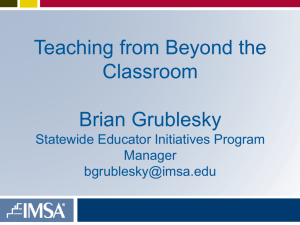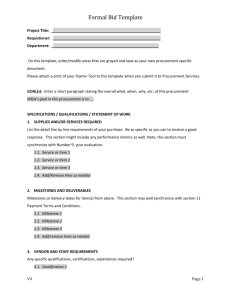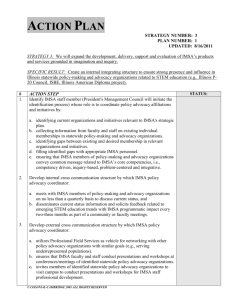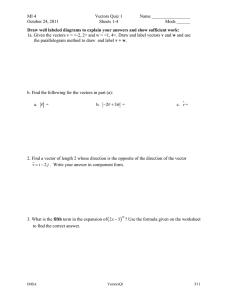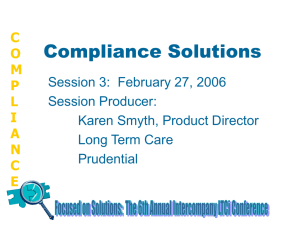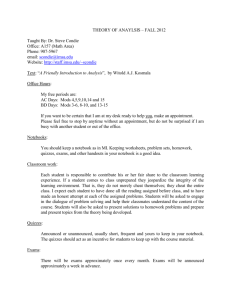Illinois Mathematics and Science Academy Aurora, Illinois www3.imsa.edu/
advertisement
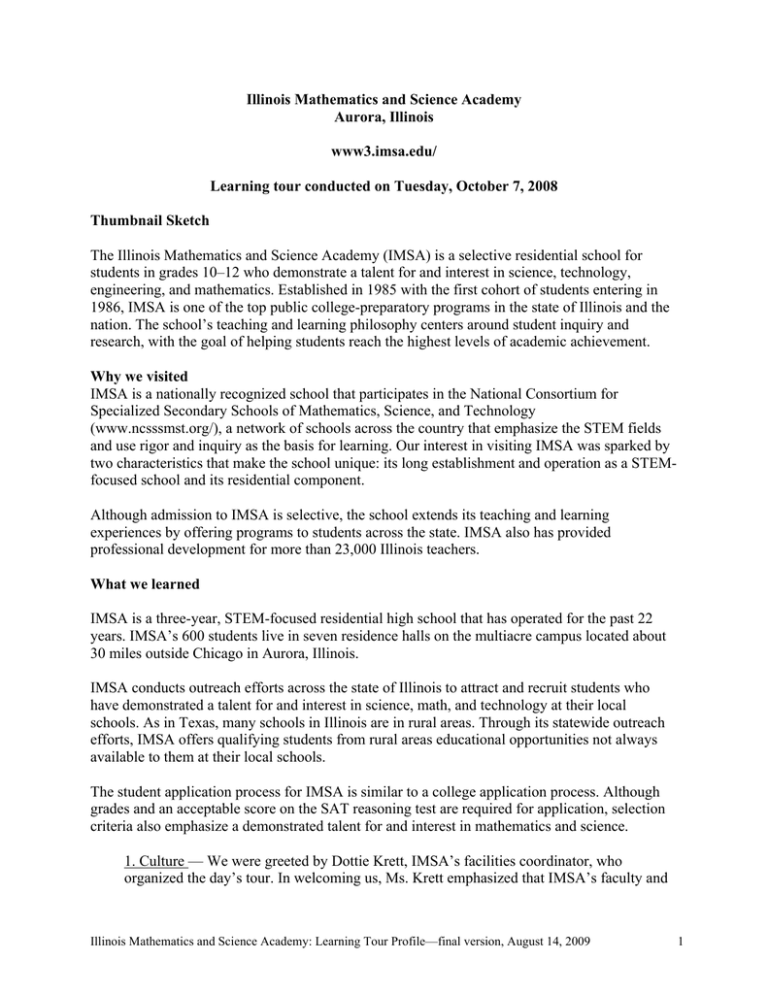
Illinois Mathematics and Science Academy Aurora, Illinois www3.imsa.edu/ Learning tour conducted on Tuesday, October 7, 2008 Thumbnail Sketch The Illinois Mathematics and Science Academy (IMSA) is a selective residential school for students in grades 10–12 who demonstrate a talent for and interest in science, technology, engineering, and mathematics. Established in 1985 with the first cohort of students entering in 1986, IMSA is one of the top public college-preparatory programs in the state of Illinois and the nation. The school’s teaching and learning philosophy centers around student inquiry and research, with the goal of helping students reach the highest levels of academic achievement. Why we visited IMSA is a nationally recognized school that participates in the National Consortium for Specialized Secondary Schools of Mathematics, Science, and Technology (www.ncsssmst.org/), a network of schools across the country that emphasize the STEM fields and use rigor and inquiry as the basis for learning. Our interest in visiting IMSA was sparked by two characteristics that make the school unique: its long establishment and operation as a STEMfocused school and its residential component. Although admission to IMSA is selective, the school extends its teaching and learning experiences by offering programs to students across the state. IMSA also has provided professional development for more than 23,000 Illinois teachers. What we learned IMSA is a three-year, STEM-focused residential high school that has operated for the past 22 years. IMSA’s 600 students live in seven residence halls on the multiacre campus located about 30 miles outside Chicago in Aurora, Illinois. IMSA conducts outreach efforts across the state of Illinois to attract and recruit students who have demonstrated a talent for and interest in science, math, and technology at their local schools. As in Texas, many schools in Illinois are in rural areas. Through its statewide outreach efforts, IMSA offers qualifying students from rural areas educational opportunities not always available to them at their local schools. The student application process for IMSA is similar to a college application process. Although grades and an acceptable score on the SAT reasoning test are required for application, selection criteria also emphasize a demonstrated talent for and interest in mathematics and science. 1. Culture — We were greeted by Dottie Krett, IMSA’s facilities coordinator, who organized the day’s tour. In welcoming us, Ms. Krett emphasized that IMSA’s faculty and Illinois Mathematics and Science Academy: Learning Tour Profile—final version, August 14, 2009 1 staff “all try to make IMSA a place where students feel comfortable about being interested in math or science. Many of our students did not feel that they fit into their home campuses. We all try to make our campus a supportive and nurturing environment that emphasizes students’ natural talents and interests.” This philosophy was borne out by what we observed on the tour. The IMSA campus, with its main building, residence halls, and outdoor sports facilities, has the look and feel of a small college, with students studying everywhere and teachers casually stopping by to talk with them. Students seemed comfortable having their teachers give them impromptu instruction about a math problem or answer a question about a paper. There were few restrictions on where students could be, and the campus felt like it belonged to the students. Ms. Krett remarked that “the school building is open all the time. It’s where kids get their meals, so they can come have dinner and go to a lab or meet for a study group and use the classrooms to facilitate their meeting. This campus belongs to the students.” The students looked like regular high school students—we observed the early morning rush to get to classes and the murmur of conversation about assignments and tests as we moved through the hallways. Students carried laptop computers along with backpacks, books, MP3 players, and cell phones. However, the conversations overheard reflected academic concerns about their research and their grades, as well as questions such as “How did you get that answer? Because I have something different.” or “Can we pull together a study group this afternoon so we can finish this lab?” Our brief tour that morning showed that learning and teaching take place everywhere at IMSA. Although rigor and excellence are priorities for IMSA students, the campus also provides cultural and social activities. Dr. Judy Scheppler, the Student Inquiry coordinator, and Ms. Krett said that teachers and staff stay at the school long after classes have ended, helping students establish and run organizations such as the Asian Students Organization and the Thespian Club. Students and teachers also create opportunities to discuss and debate ethical and national issues. The residence halls give students time for recreation and social interaction after classes have concluded for the day. 2. Academics — Classes at IMSA run from 7:30 to 4:15 on Mondays, Tuesdays, and Thursdays. Wednesdays are set aside for students to participate in off-campus student internships, research, or study skills sessions (to fill in gaps when performance is not proficient). The Friday class schedule is flexible, and once per quarter, students may leave campus and return home for a long weekend. Teachers teach four class periods a day, and in all their classes, they model the inquiry process: plan, investigate, analyze, and communicate. Class work emphasizes this process across the content areas. Students are expected to ask substantive questions and seek answers to those questions as a means of mastering the rigorous curriculum. Throughout the day, teachers repeatedly commented that “students must own their learning, and we have to help them along the way.” Illinois Mathematics and Science Academy: Learning Tour Profile—final version, August 14, 2009 2 Although many of the classes we visited used the traditional lecture format, the teachers did emphasize connections among the content areas. The content areas are organized along traditional departmental lines; intensive integration and collaboration take place within the Student Inquiry and Research program. 3. The Student Inquiry and Research (SIR) Program — After completing a year at IMSA in good academic standing, students are eligible to participate in the SIR program, a yearlong, one-credit course. Inquiry Days (usually Wednesdays) are set aside for IMSA students to pursue their SIR projects. Students identify a question or topic that interests them and then investigate that topic following the inquiry process outlined above. Students can work alone or collaborate on an investigation. All participants in the SIR program must have an advisor for their project, and often the advisor is a scholar or professional from outside IMSA. Dr. Scheppler, the SIR coordinator, describes Inquiry Days as self-directed days of study around a student’s area of research. She continues, “I coordinate the areas of research and schedule students to come to the Grainger Center, but each student has to have an advisor, like a faculty advisor for a master’s thesis, to conduct research in a STEM area.” Collaboration with university research labs, local research and teaching hospitals, area research laboratories, architects, and other nationally recognized organizations located in the northern Illinois area provide inquiry and research opportunities for IMSA students. The students identify an area of study and, with the help of an IMSA advisor and the students’ research associate outside of IMSA, design a study that culminates in an academic paper and presentation at the poster session during the IMSAloquium. IMSA advisors maintain academic and university connections. These collaborations allow IMSA teachers to stay current in their academic fields and give them an opportunity to work alongside the students while completing their research projects. The Grainger Center is home to the SIR program and is equipped with the essential equipment students need to conduct scientific experiments. In addition, Dr. Scheppler provides a variety of other resources, both online and on campus, for students to use in their investigations and research. For example, the Center provides access to a wide range of online databases students can use to collect data. According to Dr. Scheppler, “The Grainger Center is the heart of IMSA and the place that students learn to learn.” The SIR program encourages and enables students and teachers to pursue answers to hard questions and contribute to solving complex problems through inquiry. Annually, SIR students present their research work at the IMSAloquium Student Investigation Showcase. Approximately 85% of the graduating class of 2009 participated in the SIR program. (Students are not required to complete their research program through SIR, but they must demonstrate a mastery of research and inquiry through a capstone experience, and most choose to use the SIR program to satisfy that requirement.) Illinois Mathematics and Science Academy: Learning Tour Profile—final version, August 14, 2009 3 Who is the Illinois Mathematics and Science Academy? Students: The IMSA student body is ethnically diverse, with 43% of its students white, 36% Asian American, 8% African American, 6% multiethnic, 5% Latino/a, and 2% not reported or other. Females and males are equally represented. IMSA also strives to have students from all over the state of Illinois. To this end, several outreach programs have been established, such as IMSA Excellence 2000+ (E2K+) and PROMISE for students in grades 4–9. E2K+ provides a challenging after-school experience for Illinois students in grades 4–8 who are historically underrepresented in mathematics and science fields of study. The E2K+ curriculum was developed by IMSA staff and emphasizes research skills, inquiry, and problem-based learning using topics that have relevance in students’ lives. The PROMISE program runs in the summer and includes visits to targeted schools from IMSA faculty and students, an enrichment program in mathematics, and an early introduction to the IMSA program. Instructional Staff: Most IMSA teachers have a master’s degree in their content areas, and several have PhDs. Several IMSA teachers have attained National Board Certification. One of the science teachers told us that learning for the professional staff does not stop, ever. For professional development, teachers continue to work with their connections in higher education as well as with the community partners who mentor and provide internships for IMSA students. IMSA teachers are proud that they continue to learn actively alongside their students. Campus leaders at IMSA recognize the importance of having excellent teachers and have worked to develop a pool of talented candidates. Teachers from Illinois and other states are asked to apply for future openings; when IMSA needs to hire a new teacher, they can draw from this pool of “the best and the brightest,” as Dottie Krett put it. IMSA demonstrates that recruiting highly qualified teachers is paramount in providing an excellent education for students. Illinois Mathematics and Science Academy: Learning Tour Profile—final version, August 14, 2009 4
